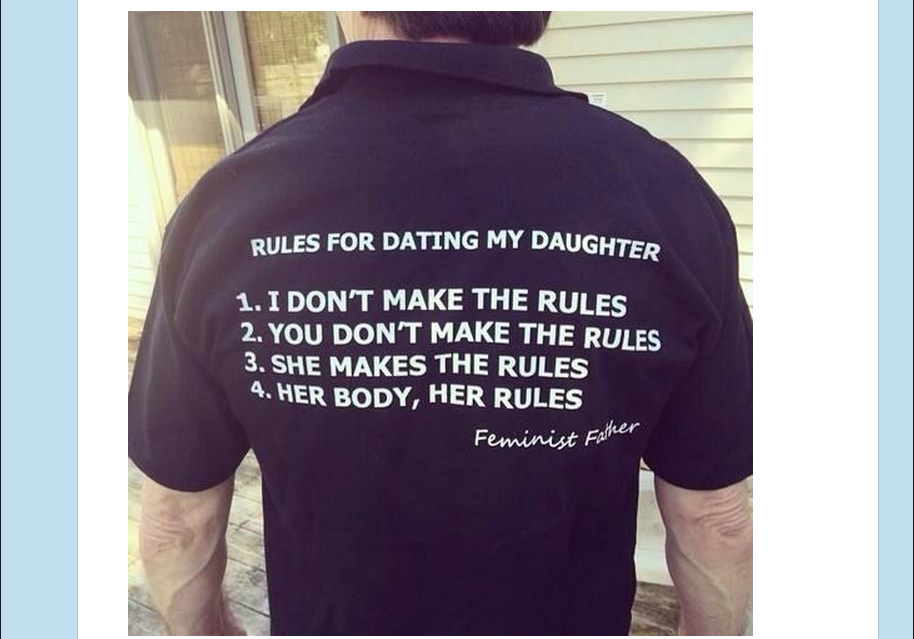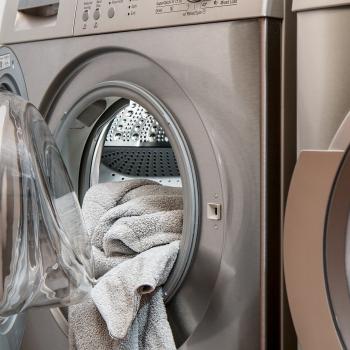A while back, I posted about the sexist way our society approaches fathers, daughters, and dating. You know, the whole “I’ll have to get a shotgun to keep the guys away from my daughter” meme and the “I’m not letting her date until he’s thirty” line. I know, I know, I’ve had people insist to me that it’s a joke and I’m taking it too seriously, but I’m sorry, if it’s a joke it’s a sexist joke that perpetuates sexist ideas about women and removes agency from girls and women.
Take a look at this shirt:

This shirt lays out ten “rules for dating my daughter”:
1. Get a job
2. Understand that I don’t like you.
3. I’m everywhere.
4. You hurt her, I hurt you.
5. Be home 30 minutes early.
6. Get a lawyer.
7. If you like me, I will find out.
8. She’s my princess, not your conquest.
9. I don’t mind going back to jail.
10. Whatever you do to her, I will do to you.
The central problem with all of these memes is that they ignore the daughter’s agency. As parents, we need to focus on empowering our daughters rather than on cloistering our daughters. Even a focus on protecting our daughters doesn’t work once they reach a certain age—what’s to stop a daughter whose father takes this approach from simply ditching her dad and running off with a guy, but without the tools to recognize abusive patterns or stand up for herself? We need to be teaching our daughters skills and putting agency in their hands rather than steamrolling their self-determination.
Anyway, someone made a counter list, which you can see here:

This one reads “rules for dating my daughter” and lists these:
1. I don’t make the rules
2. You don’t make the rules
3. She makes the rules
4. Her body, her rules
This approach, as you may notice, places agency in the daughter’s hands and seeks to empower her. But what I didn’t notice at the time I first wrote about these memes was that several weeks after my post on the subject the Federalist posted an article titled “3 Inadvertent Truths In Feminist ‘Rules For Dating Daughter’ T-Shirt.” The article, written by writer Mollie Hemingway, focuses on the shirt pictured above.
The shirt suggests that we’re talking not about an adult woman but an underage daughter. And while I know we all thought we knew everything when we were 15, we in fact knew nothing at all whatsoever oh my goodness wasn’t it embarrassing we were so foolish I’m so glad we survived how did we survive.
So the idea that parents wouldn’t have dating rules during the parenting process is mostly just an abdication of parenting as opposed to some kind of feminist empowerment thing. It took me years to realize this but parents who didn’t have rules for their teens tended to be parents who just didn’t care enough about their kids to provide guidance.
I made that last line bold for emphasis because I’ve never seen this nonsense idea stated so plainly before. This idea that parents either have rules or don’t care about their kids is not at all reflected in my experience as a progressive parent surrounded by other progressive parents. Notice that Hemingway contrasts parents who “have rules for their teens” with parents who “just don’t care enough about their kids to provide guidance,” as though the only way to provide guidance is through rules. Are there parents who don’t provide guidance? Absolutely! Ironically, many of them are the same ones who make lots of rules for their kids, because rules are not the same thing as guidance. Rules provide external control. I want to give my children internal control. There’s a difference.
More than that, I believe that trust is mutual, and that communication is a two-way street, and that the two, if given a solid foundation during a child’s early years, can carry a parent and child safely through the teen years. I know, my oldest is only six, but I know people with older kids who are taking this approach, and I’ve seen it work. You don’t need rules to raise a teenager, or a small child for that matter. You need parents and children who are willing and able to communicate about expectations, needs, and priorities. Are there parents who “just don’t care about their kids who provide guidance”? Absolutely. But this dichotomy between parents who make lots of rules and parents who don’t care about their kids is bullshit.
But I’m rather getting off track here. Next Hemingway says this:
But that gets me to the main reflection of this piece. While the shirt claims it’s from “feminist father” — it actually has some really good ancient wisdom woven throughout it.
Do tell . . .
1) Still Dad’s Rules
You’ll note that while the message is supposedly that the daughter makes the rules, there are in fact three additional rules after “I don’t make the rules.” And what this really shows us is the importance of having a dad around to provide the guidance he kind of claims he’s not providing.
If the father is out of the picture or not around to discuss rules, relationship outcomes are in fact less desirable. As the National Fatherhood Project puts it:
Being raised by a single mother raises the risk of teen pregnancy, marrying with less than a high school degree, and forming a marriage where both partners have less than a high school degree.
They also have data suggesting that the absence of a father is tied to greater risk of abuse, neglect, malnutrition, obesity, delinquency and incarceration, aggressive behavior and relationship instability.
So just the presence of this father is a powerful, powerful message to the daughter and to those she might date. And his mere presence is a positive factor in all sorts of outcomes.
Wait wait wait wait wait. “I don’t make the rules” is not the same thing as “I don’t provide guidance.” The dad in in this meme is most definitely not claiming to not provide guidance. The remainder of his rules make it very clear that he is all for guidance, just not for making lots of rules—remember, rules and guidance are not the same thing (see my discussion above). And seriously, look back at the first meme—that’s not “guidance”, that’s petty rule-making.
Also, did I miss something, or are conservatives against early marriage now?
Yes, there are benefits to a child having two (or more) adults involved in their upbringing. This is why we should support marriage equality, and it’s also why we should work to value family structures that look unlike the stereotypical nuclear family. For example, one of my daughter’s friends who has a single mother lives with both his mother and her parents, who participate in raising him alongside his mother. Another of my daughter’s friends who has a single mother lives with her mother and her aunt, and sees her father regularly on weekends. Conservatives would likely characterize both of these families as “broken,” but I would rather focus on the diversity of family structures and on valuing all of the adults involved in childrearing, whether they are a child’s biological parents or not.
Besides, when a father is absent there are generally reasons for that. We can’t compare the wellbeing of children in families where the fathers are present to that in families where the fathers are absent because there are more differences there than the absence of the father, because the father is generally absent for reasons, and those reasons need to be factored into any comparison. Are children with two parents in the home better off? No duh! Would children with one parent in the home be better off if their other parent had stayed in the home? In some cases perhaps, but very often no! That’s the distinction conservatives can’t seem to make.
But look again at that last line:
So just the presence of this father is a powerful, powerful message to the daughter and to those she might date. And his mere presence is a positive factor in all sorts of outcomes.
The problem here appears to be that Hemingway is reading cultural ideas about the father as the protector—and as someone boyfriends should be afraid of—into a message that is trying to counter those cultural ideas. And it’s true, we can’t just wipe those cultural ideas from society. The meme could have been signed “Feminist Parent” and worn by someone whose gender was ambiguous, but it’s not, because it’s trying to counter the idea that all fathers are overprotective assholes. And apparently you can’t counter that meme without someone saying “hey look, a father is involved in his daughter’s life, that’s scary to boyfriends!” Lovely. Just lovely.
But you know what? This isn’t an “inadvertent truth” in a feminist meme, it’s a sign that our society’s sexism is deeper than either I or the author of the meme realized.
2) Reinforces Women’s Sexual Gatekeeping Role
It’s totally controversial to say it, but it’s also true, that women are generally the ones in a sexual relationship to decide what level of intimacy — and when — will occur. Here’s an animated discussion of some of why that is:
Some feminists objected to that video on the grounds that “it’s bursting with false and blatantly sexist claims, like the ideas that men want sex more, women want marriage more, and the decline of marriage rates will destroy the world.”
Ah yes, where would anyone get the idea that men generally want sex more? Maybe from observing people with pulses or maybe from stuff like this:
CLARK AND A GROUP of students planned out a simple experiment, which played out in the spring of 1978: Five college-aged women and four college-aged men took turns standing at one of five quadrangles on the Florida State campus on a weekday. There, they’d wait until they spotted a member of the opposite sex, who — in their judgment — was attractive. They’d approach their target, and, in a cool, calm voice, state, “I’ve been noticing you around campus. I find you very attractive.” The experimenter would then ask one of three randomly assigned questions: “Would you go out with me tonight?” “Would you come over to my apartment tonight?” or “Would you go to bed with me tonight?” The results were fascinating. A total of 96 subjects — 48 men and 48 women — were propositioned, partitioned to 32 — 16 men and 16 women — for each question. Roughly half of the men and half of the women agreed to go on a date. But, when the suggestion turned sexual, the difference in responses between the genders was stark. None of the women agreed to go to bed with their male askers, and only one agreed to visit a male experimenter’s apartment. On the other hand, roughly three-quarters of propositioned males were happy to oblige such titillating proposals.
This is not to say that all of us XX folks want less sex than some men, just that, you know, in general there are biological distinctions between the sexes that result in different preferences.
This “feminist” t-shirt also says that the rules for dating are set by the daughter — and explicitly not by the guy dating her. They’re not setting them together or some such, she’s the one who has control. It’s true, but it’s kind of surprising to see it on a feminist t-shirt, even if the intended message is simply about feminist agency.
Are you kidding me?!
Let’s talk about the study Hemingway mentions. If a woman is approached by a man who asks her point-blank to come to his apartment and have sex with her, she’s going to have immediate alarm bells saying “this is a creep stalker, this is a dangerous situation, RUN” that have nothing at all to do with whether she wants sex and everything to do with the prevalence of sexual assault and the sexist world women must navigate! If a man is approached by a woman who asks him point-blame to come back to his apartment with him, he doesn’t have to make any of those calculations, and is free to give rein to his desires while a woman is not. The idea that such a study would say anything about whether men or women want sex more is absurd.
You know what’s interesting? I’ve heard way more of my female friends complain that their libidos are higher than their partners’ libidos than the other way around. Based solely on anecdotal evidence, I’d guess that men and women’s libidos are about the same, and that an equal number of relationships end up mismatched in either direction. In my own relationship, there are times when I want sex and my husband doesn’t, and vice versa. If nothing else, I think it’s tilted slightly in my direction—that I want sex slightly more often than my husband does. The idea that men naturally have higher libidos does not match my personal experience or that of my friends at all.
And you want to know something else? In the middle ages it was believed that women had stronger sex drives than men, and that women were more sexual and more carnal. Yes, really. This only changed in the last two hundred years when the Victorians elevated women to a pedestal of spiritual goodness that required erasing the very existence of women’s sexual desires, because the carnal and the spiritual were seen as in conflict. I’m not making this shit up. The fact that we as a society view men as more sexual than women is a historical abnormality.
The core of Hemingway’s argument has to do with these two lines from the meme:
3. She makes the rules
4. Her body, her rules
Hemingway argues that this reinforces “women’s sexual gatekeeping role,” apparently unaware that the feminist emphasis on consent goes both ways. Her body, her rules—his body, his rules. Perhaps the meme could have made this more explicit on this front, or perhaps it should have been accompanied by a meme geared toward girls dating someone’s son. But one thing I intend to teach my son as he grows older—and I’m sure my husband will teach him this as well—is that just as he should not to touch a partner’s body without her (or his) consent, his partner should not touch his body without his consent. Each person has the right to set their own rules for what others may or may not do to or with their body, regardless of gender.
The rules in this meme are about consent, and consent is far different from emphasizing “women’s sexual gatekeeping role”—unless, I suppose, you assume that all men always want sex and all women don’t want sex without a ring on their finger.
3) Women need protection
The other thing about the viral image is that the dad is buff. He’s subtly letting everyone know where the gun show is, if you know what I mean. There’s a strength in the image and it’s what makes the visual so powerful. Imagine if it were some scrawny, wimpy dude who was wearing it. It would have a totally different effect.
This speaks to the reality that women and men are biologically different and that women have vulnerabilities — particularly related to reproduction, honestly — that require societies to protect them. Whether that means protecting them from non-consensual sex or reproduction or protection from external threats while gestating and sustaining lives of children that result from sex.
This isn’t a bad thing — it’s one of the cool ways that men can use their natural gifts to everyone’s advantage. It’s just a truth that is usually downplayed or denied or treated in a less straight-forward manner.
First of all, I don’t think the dad in this image is buff on purpose. Also, I don’t appreciate the shaming of “scrawny” dudes or the assumption that “scrawny” dudes are automatically “wimpy.” Not cool.
But the real issue here is this: If men are buff so that they can protect women (who are ostensibly vulnerable), who protects women from men? I’ve written a lot on this blog about abuse. The other day I saw the statistic that one in three women will be in an abusive relationship at some point in their lives. And lest you think that their fathers should step in and defend them in those situations, (a) plenty of women have abusive or controlling fathers and (b) once a woman is an adult she makes her own choices, and even a loving parent can’t abduct a woman out of an abusive relationship.
Our better bet is to focus on giving our daughters the awareness to recognize abusive situations and dynamics, the know-how to navigate out of such situations, and the tools they need to defend themselves. After all, look back at Hemingway’s comments—who exactly do women need defending against, in her telling? Men, presumably. Given this, why would Hemingway think it wise for women to depend on men for defense against men? How is it not obvious that equipping women to protect themselves makes more sense than urging women to depend on men for protection from other men?
Look we don’t live in an era where might makes right. We live in an era where it is the role of the police to respond to domestic disturbance reports and the role of the legal system to deal with abusive partners. In this era, it matters less that women are, on average, less strong than men, because it is not physical strength that matters. This isn’t to say that physical strength is irrelevant—we have our daughter in martial arts because we believe in giving girls the tools they need to protect themselves—but rather to say that we don’t live in a world where women need their male family members to protect them with threats of violence.
Hemingway finishes by describing the T-shirt like this:
Anyway, not quite a feminist t-shirt so much as an old-fashioned paternalistic one with a slightly modern edge. But not the worst thing to go viral in recent months.
How nice of Hemingway to throw around a label like “paternalistic” right after stating—with a straight face—that women need protection. In the end, though, I am left thinking about the ways people take facts and numbers and force them into their existing worldview rather truly weighing them.
1. Hemingway reads statistics on decreased outcomes for children of single mothers and concludes that the problem is the lack of paternal influence rather than asking what factors may be contributing and what we can realistically do to contribute to the wellbeing of children of single mothers.
2. Hemingway reads a study that women are less likely than men to accept sexual propositioning from a stranger and concludes that women desire sex less often than men, rather than considering the various factors that make women less able to give reign to their sexual desires.
3. Hemingway looks at women’s reduced physical strength vis a vis men and concludes that women need men to protect them, rather than turning to the structures we put in place to create a society that does not turn on a person’s strength, and ways we can improve these structures.
I am aware that progressives are not immune from doing this same thing. But I am not simply a progressive, I am an academic, and as an academic I am trained to unpack the layers and ask questions about what a study or a statistic does or does not tell us. I would like to see every high school student take a class on statistics and learn to analyze studies and data with a critical eye. But I digress.
It is Hemingway who promotes a paternalistic view of women and it is Hemingway that seeks to disempower them by making them dependent on the men in their lives. That she looks at a feminist message intended to empower women and girls and only sees her own paternalism reflected back at her is profoundly sad.
Stay in touch! Like Love, Joy, Feminism on Facebook:















